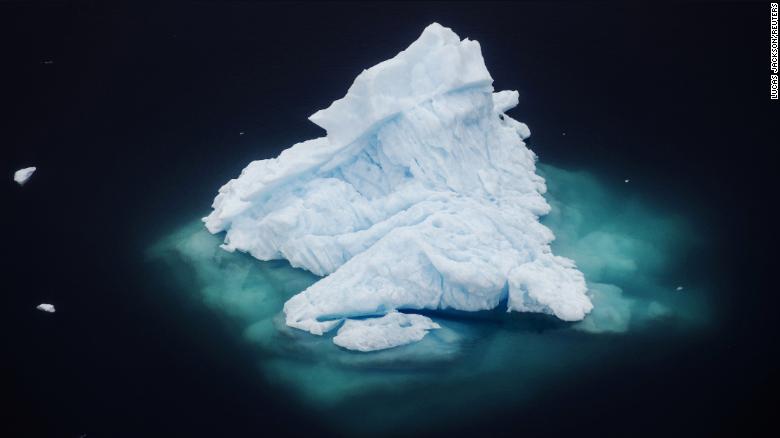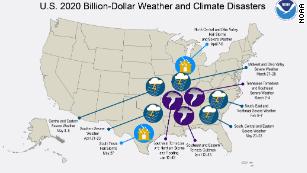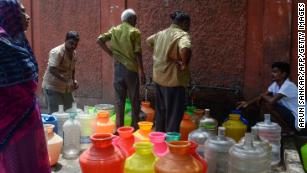
From the Website of CNN NEWS
links: https://edition.cnn.com/2020/09/10/world/climate-global-displacement-report-intl-hnk-scli-scn/index.html
Climate crisis could displace 1.2 billion people by 2050, report warns
(CNN)The global climate crisis could see more than a billion people displaced from their homes in the next 30 years, as ecological disasters drive mass migrations and greater armed conflict, according to a new report released Wednesday.
The Ecological Threat Register, conducted by the Sydney-based Institute for Economics and Peace (IEP), projected that as many as 1.2 billion people around the world could be displaced by 2050. No country will be able to escape the impact of the climate crisis -- but the world's poorest and most vulnerable populations will be hardest hit.
"Ecological threats and climate change pose serious challenges to global development and peacefulness," the report said. "The world's least resilient countries, when faced with ecological breakdowns, are more likely to experience civil unrest, political instability, social fragmentation and economic collapse."
The report drew on data from international organizations like the United Nations, the Internal Displacement Monitoring Centre, the Food and Agriculture Organization, and the IEP's prior research on countries' resilience levels. Using these figures, the IEP then calculated the relative threats of population growth, water stress, food insecurity, droughts, floods, cyclones, and rising temperature and sea levels.
It found that more than a billion people lived in 31 countries that had low resilience -- meaning they aren't equipped to withstand the impact of ecological change in the coming decades.
The regions facing the highest number of threats are Sub-Saharan Africa, South Asia, the Middle East and North Africa, the report said.
"Not all of these people will be displaced, however it is likely that a large number of them will be," said the IEP.

An iceberg floats in a fjord near the town of Tasiilaq, Greenland, in June 2018. Greenland is often considered by scientists to be ground zero of the Earth's climate change. The massive island is mostly in the Arctic, which is warming twice as fast as the rest of the planet. Melting ice from Greenland's ice sheet is the largest contributor of all land sources to the rising sea levels that could become catastrophic for coastal cities around the world. "Seeing the size of these icebergs in the water was like looking at entire city blocks floating around," Reuters photographer Lucas Jackson said.
Better-resourced countries in places like North America and Europe will be more able to manage the effects of these disasters -- but they'll likely face huge flows of climate refugees, the report warned.
"This will have huge social and political impacts, not just in the developing world, but also in the developed, as mass displacement will lead to larger refugee flows to the most developed countries," said IEP founder Steve Killelea in a news release, adding that ecological change was "the next big global threat to our planet."
Food and water scarcity
The global population currently stands at 7.8 billion. That number is expected to reach 10 billion by 2050 -- straining the world's already stretched natural resources, the report said, citing data from the UN's Department of Economic and Social Affairs.
Most of this population growth is expected to take place in countries with ongoing armed conflict, like those in Sub-Saharan Africa, the report said.
Citing research from the global non-profit organization World Resource Institute, the report projected that by 2050, global demand for food will increase by 50% and 3.5 billion people could suffer from food insecurity.
Water scarcity may be an even bigger issue -- already, there are more than 2.6 billion people facing high or extreme water stress, meaning they either don't have enough water for their needs or that their water supply is at risk of disruption, the report said.
Climate change has caused disrupted rainfall, rising temperatures, and other ecological impacts that are already creating water crises -- in 2019, Chennai, India's sixth biggest city, nearly ran out of water. Water had to be trucked in daily from other states, with people standing in line for hours in the sun to fill up jugs with their daily water ration.
By 2040, a total of 5.4 billion people -- or more than half of the world's projected population -- will live in countries facing high or extreme water stress. India and China, the world's top two most populous countries, will be among those countries, the report said.
It could also spell even greater violence and conflict, which not only destabilizes economies and governments but drives mass migration. In the past decade alone, water-related violent incidents have increased by 270% worldwide, the IEP said, citing water solutions company WorldWater.
Natural disasters
Recent years have seen dramatic increases in natural disasters around the world, which experts have long warned are the symptoms of a worsening climate crisis -- raging wildfires in California,heat waves across Europe, fears of a dam collapse in China and a record-breaking hurricane in the southern United States.
Asia-Pacific has been the most affected region; 29% of all natural disasters in the past 30 years have taken place there, the study found. Europe had the second highest numbers of natural disasters globally.
In 2019, India faced the largest population displacement due to natural disasters, with 5 million people having to leave their homes, the study said. Globally, natural disasters displaced 25 million people last year -- and the number will likely keep rising, the research team found.
And these natural disasters strike hardest in poorer countries; they kill seven times more people in the least developed nations than in highly developed ones, the report found, using socioeconomic indicators from the IEP's previous research on ecological resilience. It's not because the disasters in poorer countries happen more frequently or with greater severity -- but because those nations are less able to handle the shock.
International cooperation and foreign climate-related aid will be essential in mitigating these effects and helping developing countries build better resilience, the report said. This type of international aid has already increased 34 fold from 2000 to 2018 as the full extent of the crisis became clear -- but they still "fall well short of what is needed to address these issues going forward," the report warned.
The Ecological Threat Register, conducted by the Sydney-based Institute for Economics and Peace (IEP), projected that as many as 1.2 billion people around the world could be displaced by 2050. No country will be able to escape the impact of the climate crisis -- but the world's poorest and most vulnerable populations will be hardest hit.
 |
| US hits 10th billion-dollar weather disaster of the year -- at a record pace |
The report drew on data from international organizations like the United Nations, the Internal Displacement Monitoring Centre, the Food and Agriculture Organization, and the IEP's prior research on countries' resilience levels. Using these figures, the IEP then calculated the relative threats of population growth, water stress, food insecurity, droughts, floods, cyclones, and rising temperature and sea levels.
It found that more than a billion people lived in 31 countries that had low resilience -- meaning they aren't equipped to withstand the impact of ecological change in the coming decades.
The regions facing the highest number of threats are Sub-Saharan Africa, South Asia, the Middle East and North Africa, the report said.
"Not all of these people will be displaced, however it is likely that a large number of them will be," said the IEP.

Photos: This is what climate change looks like
An iceberg floats in a fjord near the town of Tasiilaq, Greenland, in June 2018. Greenland is often considered by scientists to be ground zero of the Earth's climate change. The massive island is mostly in the Arctic, which is warming twice as fast as the rest of the planet. Melting ice from Greenland's ice sheet is the largest contributor of all land sources to the rising sea levels that could become catastrophic for coastal cities around the world. "Seeing the size of these icebergs in the water was like looking at entire city blocks floating around," Reuters photographer Lucas Jackson said.
Better-resourced countries in places like North America and Europe will be more able to manage the effects of these disasters -- but they'll likely face huge flows of climate refugees, the report warned.
"This will have huge social and political impacts, not just in the developing world, but also in the developed, as mass displacement will lead to larger refugee flows to the most developed countries," said IEP founder Steve Killelea in a news release, adding that ecological change was "the next big global threat to our planet."
Food and water scarcity
The global population currently stands at 7.8 billion. That number is expected to reach 10 billion by 2050 -- straining the world's already stretched natural resources, the report said, citing data from the UN's Department of Economic and Social Affairs.
Most of this population growth is expected to take place in countries with ongoing armed conflict, like those in Sub-Saharan Africa, the report said.
Citing research from the global non-profit organization World Resource Institute, the report projected that by 2050, global demand for food will increase by 50% and 3.5 billion people could suffer from food insecurity.
Water scarcity may be an even bigger issue -- already, there are more than 2.6 billion people facing high or extreme water stress, meaning they either don't have enough water for their needs or that their water supply is at risk of disruption, the report said.
 |
| India's sixth biggest city is almost entirely out of water |
By 2040, a total of 5.4 billion people -- or more than half of the world's projected population -- will live in countries facing high or extreme water stress. India and China, the world's top two most populous countries, will be among those countries, the report said.
It could also spell even greater violence and conflict, which not only destabilizes economies and governments but drives mass migration. In the past decade alone, water-related violent incidents have increased by 270% worldwide, the IEP said, citing water solutions company WorldWater.
Natural disasters
Recent years have seen dramatic increases in natural disasters around the world, which experts have long warned are the symptoms of a worsening climate crisis -- raging wildfires in California,heat waves across Europe, fears of a dam collapse in China and a record-breaking hurricane in the southern United States.
Asia-Pacific has been the most affected region; 29% of all natural disasters in the past 30 years have taken place there, the study found. Europe had the second highest numbers of natural disasters globally.
In 2019, India faced the largest population displacement due to natural disasters, with 5 million people having to leave their homes, the study said. Globally, natural disasters displaced 25 million people last year -- and the number will likely keep rising, the research team found.
 |
All these threats combined will create a migration crisis that can then cause spinoff effects like heightened political instability, global insecurity and greater hostility toward immigrants.
International cooperation and foreign climate-related aid will be essential in mitigating these effects and helping developing countries build better resilience, the report said. This type of international aid has already increased 34 fold from 2000 to 2018 as the full extent of the crisis became clear -- but they still "fall well short of what is needed to address these issues going forward," the report warned.
CNN Website
Article Links
OTHER HUMAN RIGHTS PROMOTIONS WEBSITES
------------------------------------------------------------------------------------------------
THE GLOBAL WORLD PROMOTIONS
-------------------------------------------------------------------------------------------------
-------------------------------------------------------------------------------
---------------------------------------------------



































0 comments:
Post a Comment